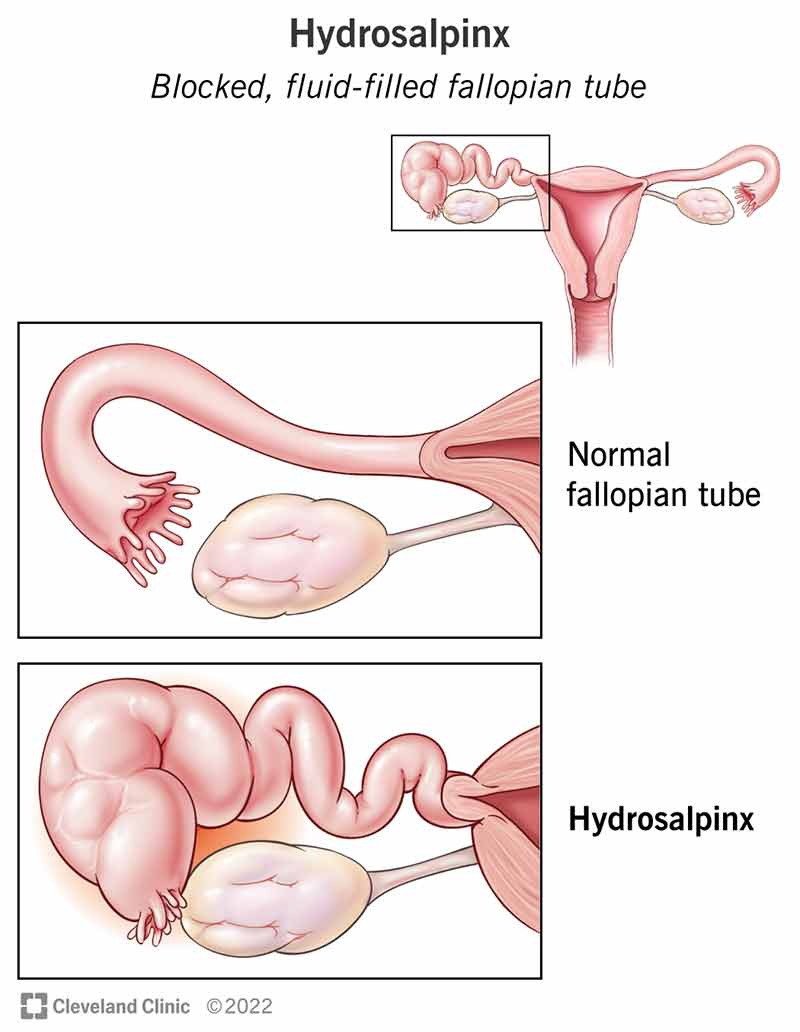A hydrosalpinx is fluid blockage in your fallopian tubes that may make it difficult for you to become pregnant. Damage to your fallopian tubes, most often from an untreated infection, can cause a hydrosalpinx. Treatments include draining and repairing the tubes or removing them (salpingectomy). Many individuals and couples who want to have a baby opt for IVF after treating a hydrosalpinx.
Advertisement
Cleveland Clinic is a non-profit academic medical center. Advertising on our site helps support our mission. We do not endorse non-Cleveland Clinic products or services. Policy

Hydrosalpinx is a condition where fluid accumulates in one or both fallopian tubes, creating a blockage. Your fallopian tubes extend from your uterus to your ovaries. Each month, as part of your menstrual cycle, your ovaries produce an egg that moves through your fallopian tubes. Healthy fallopian tubes provide an open passageway for an egg and a sperm to unite (fertilization). The fertilized egg, or embryo, travels the same open passageway to your uterus. From there, an embryo can implant in your uterine wall and develop into a fetus.
Advertisement
Cleveland Clinic is a non-profit academic medical center. Advertising on our site helps support our mission. We do not endorse non-Cleveland Clinic products or services. Policy
With a hydrosalpinx, fluid build-up blocks this passageway. A blocked fallopian tube may prevent sperm from reaching your egg. If fertilization does occur, the blockage in your fallopian tube can prevent the embryo from reaching your uterus.
Twenty to 30% of infertility cases involve problems related to the fallopian tubes (tubal factor infertility). Hydrosalpinx is present in 10% to 20% of these cases.
An untreated hydrosalpinx can make it difficult to become pregnant, and it can increase your risk of miscarriage and pregnancy complications. In addition to making it difficult to get pregnant through intercourse, a hydrosalpinx can:
Advertisement
Treating a hydrosalpinx increases your chances of a healthy pregnancy, even if you opt for IVF.
A hydrosalpinx rarely causes symptoms. You may not realize your tubes are blocked until your provider investigates what’s making it difficult for you to become pregnant.
When symptoms are present, they include:
An untreated infection is the most common cause of a hydrosalpinx. Harmful bacteria can damage your fallopian tubes and cause them to become inflamed. This inflammation often happens at the part of your fallopian tube near your ovaries, or your fimbriae. Your fimbriae are finger-like extensions that sweep an egg from your ovaries into your fallopian tubes.
As part of the healing process, your fimbriae may fuse together, sealing your fallopian tubes. Fluid gets trapped inside your tubes, causing them to swell.
Hydrosalpinx causes include:
Tests to check your fallopian tubes for a blockage include:
Treating a hydrosalpinx can improve your chances of becoming pregnant. Your treatment will depend on factors like the severity of your blockage and your age.
Advertisement
If you have an active infection, your provider will prescribe antibiotics to resolve it. Surgical treatments include:
Many individuals and couples who are trying to have a baby receive treatment for the hydrosalpinx and then opt for IVF, bypassing the fallopian tubes altogether. Your provider can advise you on the best options depending on your unique case.
There aren’t natural remedies for hydrosalpinx. If there’s only a small amount of damage to your tubes, your provider may be able to repair them with a salpingostomy. For a more severe hydrosalpinx, you may need to have one or both fallopian tubes removed.
Advertisement
An untreated hydrosalpinx decreases your odds of becoming pregnant and increases your risk of miscarriage and complications like ectopic pregnancy. Receiving treatment greatly improves your chance of a healthy pregnancy.
Hydrosalpinx on its own isn’t life-threatening, but it can increase your risk of ectopic pregnancy, which can be life-threatening without treatment.
Reducing your risk of getting an STI is the best way to avoid a hydrosalpinx. Practicing safer sex can decrease the odds of an infection that that may harm your reproductive organs.
Learning that you have a hydrosalpinx can feel like a disheartening setback when you’re trying to have a baby. But many people who receive treatment go on to have healthy pregnancies. Talk to your healthcare provider about how a hydrosalpinx will affect your pregnancy plans. Your provider is your best resource for explaining how a hydrosalpinx impacts your fertility — and the best next steps moving forward.
Advertisement
From routine pelvic exams to high-risk pregnancies, Cleveland Clinic’s Ob/Gyns are here for you at any point in life.

Last reviewed on 11/11/2022.
Learn more about the Health Library and our editorial process.